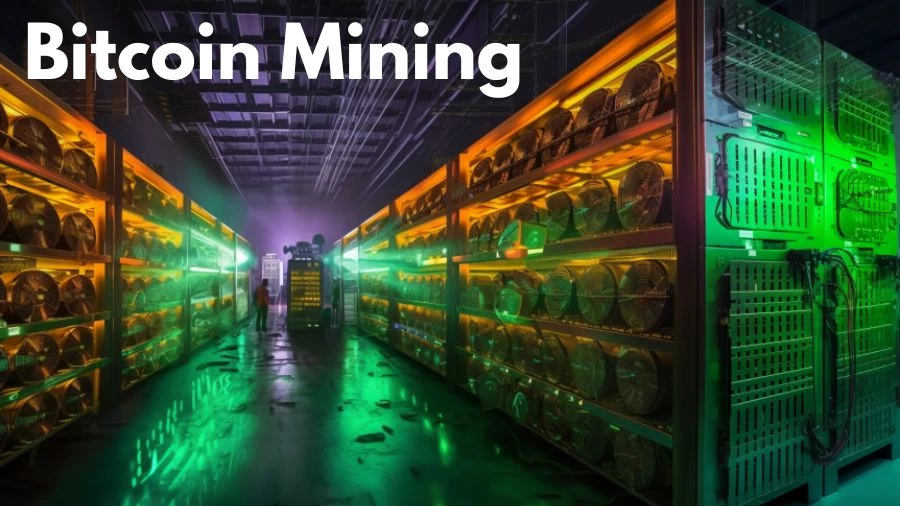
Bitcoin Mining, How Does Bitcoin Mining Work?
Bitcoin mining involves miners validating transactions by solving puzzles to update the ledger and earn new Bitcoins, ensuring secure transactions and decentralization.
by Sangamithra
Published Aug 18, 2023 | Updated Aug 18, 2023 | 📖 10 min read
On This Page
- Bitcoin Mining
- How Does Bitcoin Mining Work?
- How to Start Bitcoin Mining?
- Free Bitcoin Mining
- Is Bitcoin Mining Profitable?
- What Do the Economics of Mining Bitcoin Entail?
- What is the Process for Selecting the Most Suitable Bitcoin Mining Software?
- What are the Advantages and Disadvantages of Bitcoin Mining?
- What are the Challenges Associated with Bitcoin Mining?
Bitcoin Mining
Bitcoin mining constitutes an intricate technological and computational endeavor centered on confirming transactions within the Bitcoin network. This process mirrors the act of validating a block within the network's chain and subsequently receiving compensation in the form of Bitcoin. Individuals engaged in this mining endeavor are referred to as miners.
The term "mining" draws parallels with conventional resource extraction due to the finite availability of Bitcoins, capped at a maximum of 21 million. Just as energy investment is required for resource extraction, Bitcoin mining demands electrical energy to generate Bitcoins. Miners engage in competition to decipher intricate cryptographic hash puzzles, which authenticate blocks harboring transactions.
In this competitive endeavor, the first miner to accurately predict a specific number is granted the opportunity to update the transaction ledger on the Bitcoin blockchain. Moreover, they receive a reward in the form of newly-minted Bitcoins.
It's worth noting that these numerical predictions are executed by computers. Enhanced computational power translates to an increased number of predictions per second, enhancing a miner's likelihood of winning the competition. Bitcoin mining primarily serves the purposes of:
A) Introducing fresh coins into circulation and affirming ongoing transactions.
B) Safeguarding against counterfeiting and double-spending.
C) Sustaining a decentralized ledger system.
How Does Bitcoin Mining Work?
Bitcoin mining is the foundational process that underpins the Bitcoin network, enabling the creation of new bitcoins and securing the entire system. At its core, Bitcoin mining involves solving complex mathematical puzzles through computational power. Here's how the process works:
Transaction Verification:
Whenever someone sends bitcoins to another person, the transaction is broadcast to the Bitcoin network. These transactions are collected into a "block" along with other pending transactions.
Creating a Block:
Miners compete to create a new block of transactions by solving a mathematical problem. This problem is essentially finding a specific number (called a nonce) that, when combined with the data in the block and passed through a cryptographic hash function (SHA-256), produces a hash that meets certain criteria. This is known as finding a valid "proof of work."
Proof of Work:
The proof of work is what makes Bitcoin secure and tamper-proof. Miners must expend computational effort to find the correct nonce, and this effort is what makes it difficult for malicious actors to alter past blocks. The first miner to find valid proof of work broadcasts the new block to the network.
Network Validation:
Other nodes on the Bitcoin network validate the newly created block. They check if the transactions are valid if the proof of work is correct, and if the block adheres to the consensus rules of the network.
Block Addition:
Once the network confirms the validity of the new block, it is added to the blockchain. The blockchain is a chronological, immutable record of all transactions that have ever occurred on the Bitcoin network.
Miner Reward:
As a reward for their efforts, the miner who successfully mined the new block is rewarded with newly minted bitcoins. This is how new bitcoins are introduced into circulation. The miner may also receive transaction fees from the transactions included in the block.
Mining Difficulty Adjustment:
To maintain a consistent block creation rate (roughly every 10 minutes), the network adjusts the difficulty of the mathematical problem. If miners collectively become more powerful, the difficulty increases; if they become less powerful, it decreases. This ensures that mining remains competitive and that blocks are not created too quickly or too slowly.
Halving Events:
Approximately every four years, the block reward that miners receive is halved. This event, known as a "halving," is programmed into the Bitcoin protocol and is designed to limit the total supply of bitcoins to 21 million. The most recent halving occurred in May 2020, reducing the block reward to 6.25 bitcoins.
How to Start Bitcoin Mining?
Here are the fundamental elements needed to initiate Bitcoin mining:
Digital Wallet: Your earned Bitcoins resulting from mining efforts find a secure home in a digital wallet. This encrypted online account enables Bitcoin storage, transfer, and acceptance, extending to other cryptocurrencies. Notable providers like Coinbase, Trezor, and Exodus offer cryptocurrency wallet solutions.
Mining Software: Diverse software options from various providers, many of which are freely available for download, are compatible with both Windows and Mac platforms. Once this software establishes a connection with the essential hardware, you're primed to engage in Bitcoin mining.
Computer Hardware: A pivotal facet with a potential for high costs in Bitcoin mining is the hardware setup. A potent computer, demanding substantial electricity, is indispensable for successful Bitcoin mining. It's not uncommon for hardware expenses to scale to approximately $10,000 or beyond.
Free Bitcoin Mining
In the United States, a plethora of options are available for Bitcoin mining. These avenues encompass a range of approaches, with some being cost-free and others necessitating hardware investments.
For instance, individuals have the option to engage in cloud mining services such as StormGain1 and Kryptex2, providing access to complimentary Bitcoin mining applications and software tailored to cryptocurrency miners. Notably, Binance stands out as a top-tier Bitcoin mining provider.
Is Bitcoin Mining Profitable?
The profitability of Bitcoin mining is not guaranteed. Despite the potential for success, the question of whether mining efforts will result in profits remains uncertain due to substantial upfront expenses associated with equipment and ongoing electricity costs.
A comparative example from a 2019 report by the Congressional Research Service emphasizes that the electricity consumed by a single ASIC device could match that of approximately half a million PlayStation 3 units. As the complexity of Bitcoin mining has risen, so too has the demand for computing power.
The Cambridge Bitcoin Electricity Consumption Index reveals that Bitcoin mining utilizes approximately 121 terawatt-hours of electricity annually, exceeding the energy consumption of many countries. As of August 2021, mining a single bitcoin requires electricity equivalent to almost 9 years of typical electricity consumption in an average U.S. household.
To mitigate the financial burden of mining, some individuals opt to join mining pools. These collaborative arrangements allow miners to consolidate resources and enhance capabilities. However, the shared nature of these resources translates to shared rewards, potentially resulting in reduced payouts when operating within a pool. The unpredictable fluctuations in the value of Bitcoin further complicate the accurate assessment of potential earnings.
What Do the Economics of Mining Bitcoin Entail?
Bitcoin mining operates as a business venture, with the profits linked to the investments made in its foundational components. The process entails three primary expenses:
Electricity: The perpetual operation of mining systems necessitates a substantial electricity supply, leading to significant costs. The energy consumption can be comparable to that of certain nations, amplifying expenses. Cooling solutions are also vital to counter the heat generated during mining, adding to overall costs.
Mining Equipment: Contrary to common belief, basic systems like desktop computers can partake in mining when joining a pool. However, returns are limited due to reward division based on contributed work. To achieve competitiveness, several ASIC miners need to be acquired and pooled, with each rig's cost ranging from $4,000 to $12,000. Enhanced mining speed corresponds to higher expenses.
Network Infrastructure: While network speed minimally affects mining, latency, or communication time, is crucial. Mining farms demand multiple internal connections to link mining rigs to central routers or servers with internet connectivity. For pool-based mining using gaming rigs, additional bandwidth might not be necessary, only low latency to the joined pool.
These cumulative costs must remain lower than the output—Bitcoin's market price—in order to yield profitable results. Considering the fluctuating value of Bitcoin, the prospect of creating one's cryptocurrency can seem appealing.
However, due to the financial complexities associated with Bitcoin mining, embracing reduced profits and a prolonged period to achieve break-even post-equipment acquisition might be necessary for the evolving Bitcoin landscape.
What is the Process for Selecting the Most Suitable Bitcoin Mining Software?
Novice individuals might find favor in opting for cloud-centric software solutions, eliminating the necessity for dedicated mining hardware. Specifically tailored to rudimentary CPU and GPU mining, these programs cater to a less advanced user base.
Furthermore, a preference may exist for software platforms incorporating minimal withdrawal prerequisites. This inclination arises due to the extended period required to amass a substantial Bitcoin yield, rendering software with elevated thresholds for usage potentially impractical.
On the other hand, adept miners boasting potent systems could gravitate toward software offerings that offer an elevated degree of customization. This would empower them to harness a broad spectrum of mining apparatus, diversified mining pools, and a comprehensive toolkit for refining and customizing their mining configurations.
What are the Advantages and Disadvantages of Bitcoin Mining?
Advantages of Bitcoin Mining
- Sophisticated Infrastructure: Bitcoin mining is carried out using advanced computing setups, ensuring quick transaction verification and earning miners Bitcoin rewards.
- Transaction Validation: Mining underpins the circulation of Bitcoins by verifying and guaranteeing secure transactions, enhancing trust within the system.
- Cost-Effective: Becoming a Bitcoin miner is more economical and user-friendly than opting for undermining.
Disadvantages of Bitcoin Mining
- Environmental Concerns: Criticism from environmentalists arises due to the energy-intensive nature of Bitcoin mining, which surpasses that of entire nations.
- Complexity and Energy Consumption: The proliferation of miners worldwide leads to more challenging algorithms, demanding substantial energy for solving puzzles.
- Investment Risk: The risk of investing in equipment without rewards is a concern, with expensive hardware potentially going to waste.
- Carbon Footprint: The efficiency of ASIC chips contributes to environmental effects and increased carbon emissions.
- Energy Usage: Continuous 24/7 power consumption, comprising 90% of the total costs, impacts both efficiency and climate.
- Specialized Hardware: Regular computers are insufficient, necessitating costly specialized systems for effective mining.
- Internet Dependency: Constant, reliable internet connectivity is vital, affecting efficiency and operation times.
- Comprehensive Costs: Mining entails expenses for systems, infrastructure, internet, and electricity, with no guarantee of profits.
- Financial Volatility: The risk of loss amplifies with potential Bitcoin price drops.
- Energy Source: Dependence on fossil fuels for energy hampers sustainability, although some miners use renewable sources.
Overall, while Bitcoin mining offers rewards, it is not devoid of environmental concerns, financial risks, and infrastructure demands.
What are the Challenges Associated with Bitcoin Mining?
With odds of around one in 16 trillion, along with the challenge of scaling difficulty levels and the extensive network of users participating in transaction verification, the validation of a block of transactions occurs approximately every 10 minutes. It's important to emphasize that the 10-minute timeframe represents an objective rather than a strict rule.
Processing Speed Comparison:
Regarding speed, the current operational capacity of the Bitcoin network allows for the processing of three to six transactions per second. These transactions are logged in the blockchain approximately every 10 minutes. To provide context, Visa's capability stands at an impressive 65,000 transactions per second, as outlined in Visa's official fact sheet.
Addressing Speed Challenges:
In response to speed challenges, second-layer solutions and enhancements to the Bitcoin blockchain have been implemented. However, it remains notable that contemporary banking networks and alternative blockchains significantly surpass the transaction processing capabilities of the Bitcoin network.
The Scaling Predicament:
At the core of the Bitcoin protocol lies the critical issue of scalability, commonly referred to as scaling. While consensus exists among Bitcoin miners about the need to address scalability, there is less agreement on the optimal methods to achieve this goal. Bitcoin's attempts to tackle scalability involve incorporating upgrades and accepting contributions from off-chain layers that handle substantial portions of the workload. Nonetheless, challenges related to scalability persist.
Energy Consumption Dynamics:
Throughout much of Bitcoin's relatively brief history, its mining process has been characterized by its intensive energy usage. During the decade following its inception, China played a central role in Bitcoin mining, utilizing fossil fuels like coal for electricity generation. Notably, the substantial energy expenses associated with Bitcoin mining have attracted attention from climate change advocates. Estimates suggest that the energy consumption attributed to the cryptocurrency's mining process rivals that of entire nations.
Bitcoin Mining - FAQ
1. What is Bitcoin mining?
Bitcoin mining is the process of verifying transactions on the Bitcoin network through complex computational tasks, earning miners Bitcoin rewards.
2. Why is it called "mining"?
Bitcoin mining is named after traditional mining because there's a limited supply of 21 million Bitcoins, and energy investment is required to create new ones.
3. How do miners earn Bitcoin?
Miners compete to solve cryptographic puzzles, and the first to solve earns the right to add a block to the blockchain, along with newly-minted Bitcoins as a reward.
4. Why is Bitcoin mining energy-intensive?
Bitcoin mining demands significant energy due to computational work needed for solving puzzles, which secure the network and prevent tampering.
5. How does Bitcoin mining impact the environment?
Bitcoin mining's energy consumption, often reliant on fossil fuels, has raised environmental concerns due to its carbon footprint.




